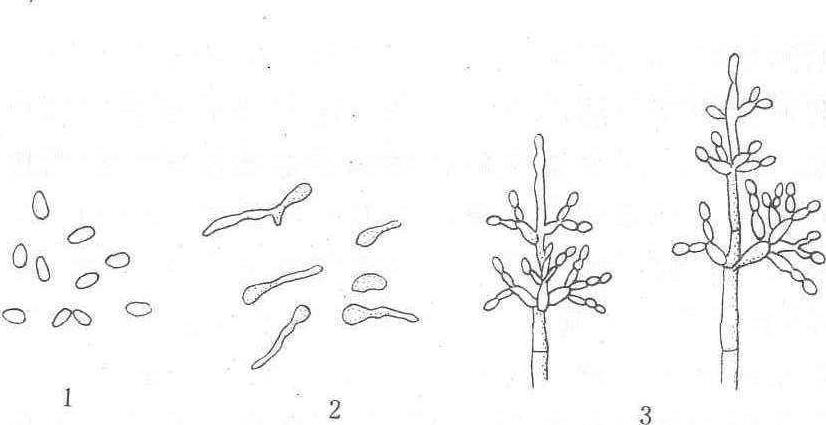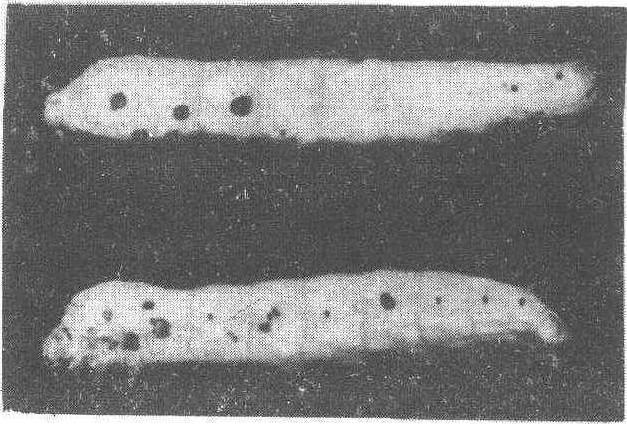绿僵病green muscardine
真菌寄生性蚕病之一,由雷氏蛾霉寄生而引起,因病蚕尸体僵硬呈绿色而得名。为害程度与季节、野外昆虫寄主多少有关,一般低温多湿的养蚕环境较易感染发病。
病原 雷氏蛾霉属丛梗孢科蛾霉属,学名为No-muraea rileyi Farlow。蚕业上俗称绿僵菌。繁殖体为分生孢子,链生于瓢形的分生孢子小梗顶端(图1)。分生孢子卵圆形,一端略尖,长宽为3.7~4.4×2.1~2.4微米,表面光滑,淡绿色。绿僵菌在培养基上生长的菌落,可生活一年左右; 病蚕尸体上的病菌在室内自然温度条件下可存活10个月。分生孢子对物理、化学

图 1 绿僵菌形态
1. 分生孢子 2. 分生孢子发芽
3. 分生孢子梗及分生孢子
传染 绿僵病的传染源,是病虫尸体表面的分生孢子。以空气、蚕具和桑叶为媒介,病菌的分生孢子附着于蚕体,经皮接触传染引起发病。在温湿度适宜时,分生孢子发芽,经体壁侵入蚕体的经过时间,2龄起蚕为16~24小时,4龄起蚕为24~40小时。芽管贯穿体壁时,先在真皮细胞层,发育成菌丝体,并渐次生出芽生孢子。此时蚕体外形与健蚕无异,血色正常。患病后期,体壁形成病斑,病菌遂进入体腔,可见很多短菌丝浮游于血液中,濒死时病菌侵入肌肉,脂肪体寄生增殖,不久蚕停止食桑死去。4龄后期或5龄期感病的蚕都死于蔟中或蛹期,尸体变硬呈绿色。
病症 病程比白僵病迟缓,自感染起约经10天发病,小蚕比大蚕稍快。感病初期无明显病症表现,后期食欲减退,发育延迟,体壁上逐渐形成少数圆形或云纹状病斑。病斑大小不一,数个相连形成的 “集合斑” 比较大,病斑大多边缘色深,中间色淡,呈环状(图2)。此时病蚕血液白浊,用600倍显微镜镜检,可看到哑铃状或豆荚状的短菌丝,其大小不等,一般为3~4×8~10微米,将眠时发病的蚕,迟迟不能入眠,体色乳白,体皮紧张发亮,行动迟缓。病斑形成后,约经1~2天,食桑停止,不久死去,未见有“自然治愈”现象。初死蚕体软,伸直,略有弹性。死后约2~3天,先在环节间膜及气门处长出纤细的白色绒毛状气生菌丝,逐渐扩展,布满全身,并产生粉末状绿色分生孢子。死后约4~5天,尸体遂成绿色僵硬状态。以后孢子色泽转暗绿色,稍加振动,极易脱落飞散。

图 2 绿僵病蚕症状
诊断与防治 发现可疑病蚕时,依照本病病症对照可作初步诊断。进一步可取病蚕血液,镜检病原,如察见上述特殊形态的短菌丝,即可确诊。防治措施主要是做好蚕室、蚕具、养蚕环境的消毒,并在此基础上加强蚕体、蚕座消毒,消灭病原,防止接触传染。同时要重视对野外昆虫,包括大田害虫和桑树害虫的驱除,防止交叉传染。注意小蚕期保温,避免低温多湿。具体措施参照白僵病防治方法。
绿僵病
秋蚕期常见的一种僵病,由真菌病原绿僵菌引起。因蚕尸上覆盖一层鲜绿色分生孢子,故名。致病过程同白僵病大致相同,但病势较缓慢,特异性病斑特点是在腹侧或背面出现黑褐色不规则轮状,云纹状病斑,病斑外围色深,中间稍淡。蚕儿死亡后,虽尸体也经“软化一硬化”的变化过程。但在此过程中尸体不产生“从尾部出现桃红色”的症状特点。取病蚕血液显微镜镜检,发现“豆荚状的菌丝体”即可作为本病早期诊断的重要依据。